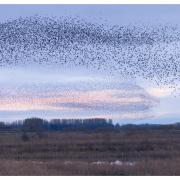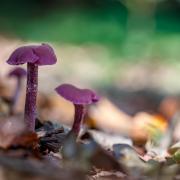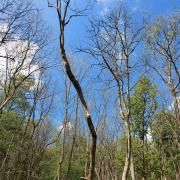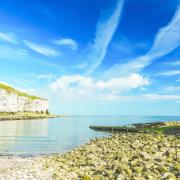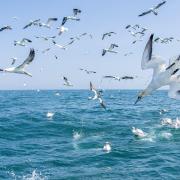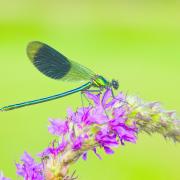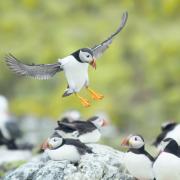April is the time to get out and discover wildlife awakening from its winter slumbers – along with exciting new arrivals, as Tom Marshall from the Yorkshire Nature Triangle reports

There’s something magical about the expectancy of spring. Although we’re not short of stunning winter wildlife spectacles here in Yorkshire – think dapper ducks in their finest attire wooing the ladies or otters seemingly oblivious to freezing waters in their pursuit of a meal – it’s still those vibrant lush greens and the impending arrival of longer days that warms the heart, and seemingly the landscape around us too.
As we head into April, there are those classic signs that summer is just a few pages of the calendar away. Swallows, martins and later on, warblers, start to drop in at migration hotspots like Spurn Point, no doubt using the unmistakable shapes of these 3D landmarks as a ‘you have reached your destination’ on their miraculous built-in sat navs. Another early arrival is often the wheatear, a handsome member of the chat family with a black face mask, silvery back and subtle orange chest, always looking at its best at these coastal arrival lounges before a busy summer among the dry stone walls of the Moors and Dales.
A little further up the coast along the 400ft cliffs of Bempton and Flamborough, the important business of the season is already well underway. More than 250,000 seabirds somehow make a home here just centimetres apart; guillemots and razorbills all dressed for dinner in crisp white shirts and black tuxedos, while kittiwakes make for a raucous reception at the party with their constant calls.
It’s the quieter residents in these high-rise seabird cities though who are well worth seeking out. Among the grassy ledges puffins may give away their presence with bright orange feet or that multi-coloured hand-painted bill, while our very own miniature albatross, the fulmar, quietly gets on with the job of raising young, making the best of an unparalleled prowess when riding the wind and waves. The most obvious cliff dwellers are of course the gannets – our largest seabird – and their romantic courtship displays and impressive 50mph plunge dives provide hours of summer entertainment.

Away from the coast the spring sunshine is not just a welcome glow, but a life-giving necessity. Among rather grandly named winter hide-outs or ‘hibernacula’, a surprisingly exotic mix of snakes and lizards are finally venturing out. These cold-blooded creatures seek out the very best sunbathing spots and spend the first couple of hours each morning revving up their internal engines by basking in the sun.
Common or viviparous lizards may be found scuttling along wooden boardwalks or sandy heathland paths at places like Allerthorpe Common, while the rarer and much maligned adder – our only venomous snake and remarkably elusive despite its reputation – prefers to sit camouflaged among the heather or bracken. The stunningly marked grass snake can be a little bolder, and the hay and grass stacks of Tophill Low are a favourite haunt, especially with myriad neighbouring pools to hunt in – ideal for these very adept swimmers.
Although our wildflower meadows are still some weeks off their dazzling best, early bloomers like lady’s smock or ‘cuckooflower’ have an important role to play for spring butterflies like the orange-tip, while the larger brimstone may already have been on the wing for a few weeks in our woodlands. Another quintessential April flower is the snake’s head fritillary, bold and mottled purple petals always sitting forlornly below an impossibly delicate green stem, with gathered clumps taking on the appearance of ringing bells in the slightest breeze.
Along the wetlands of the Humber, the whispering reedbeds soon start to echo to an altogether more haunting sound – it’s ‘boom’ time for the bitterns. These rare and highly secretive herons, often almost impossible to see among the reed stems, make up for their nondescript appearance with a far-carrying and deep booming call that can take all their energy to generate, but worth it for attracting a female in the impenetrable acres of reeds at sites like Blacktoft Sands near Goole.
Rather more obvious is the exquisite avocet, its distinctive monochrome plumage now a welcome feature along the Humber estuary at the species’ most northerly outpost. Found alongside the bittern at Blacktoft Sands, the avocet has now also made a home at North Cave Wetlands, just half an hour from Hull and Beverley – a remarkable story for a nature reserve that has been carved by a digger’s bucket alongside gravel extraction operations that still continue today.
So whether you choose a taste of spring just half an hour away or a windswept date with our globe-trotting seabirds, April has plenty to offer – just watch out for the showers.
What happened when BBC Springwatch came to Bempton Cliffs
The Yorkshire Nature Triangle
From Bempton and Flamborough in the north to Spurn, the Wolds and the Humber estuary in the south, the Yorkshire Nature Triangle is home to some of the most iconic wildlife in England – from the lovable puffin, to the magnificent red kite, the otter and a wealth of sealife.
Find out more about the Yorkshire Nature Triangle, including events and where to find interesting wildlife at this time of year, at yorkshirenaturetriangle.org.uk or follow them on Twitter @VisitYNT.












